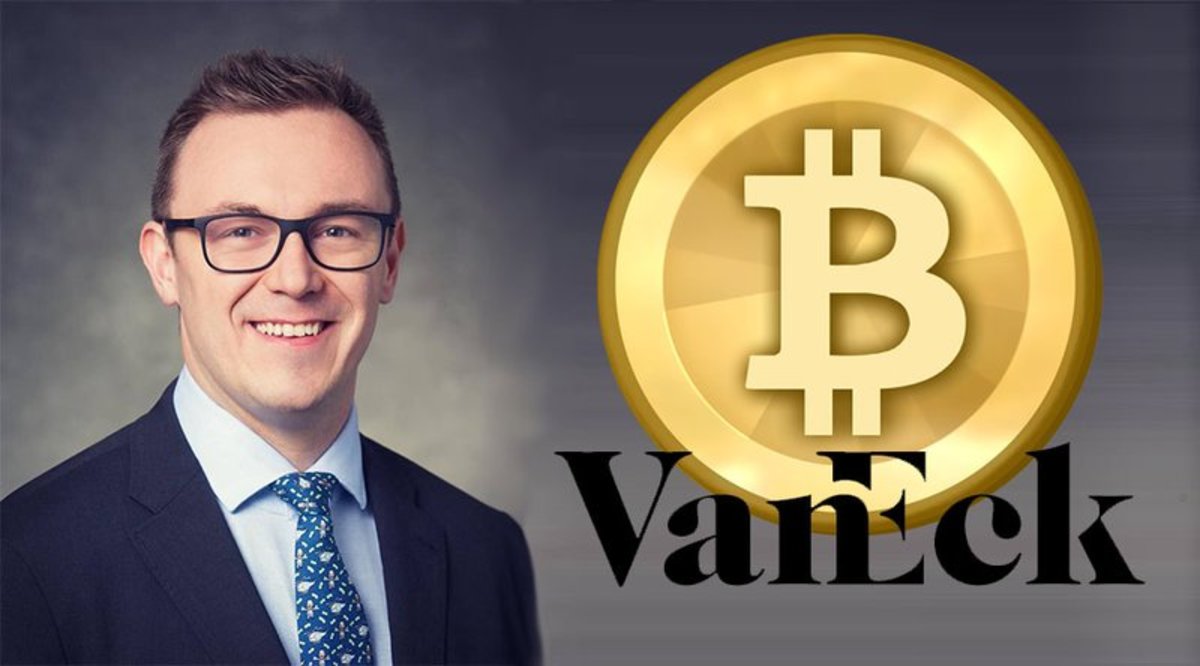
Gabor Gurbacs is confident that the approval of a bitcoin exchange traded fund (ETF) is inevitable. And he’s optimistic that the VanEck SolidX Bitcoin Strategy will be the first to deliver one to the world.
The director of Digital Asset Strategy at VanEck/MVIS, Gurbacs, as of late, has become a leading voice on the space’s ETF pursuit at a time when industry chatter on the topic has never been louder. If you haven’t found him extolling the benefits of a bitcoin ETF on Twitter, you may have come across his interviews on Anthony Pompliano’s podcast and Ran Neu-Ner’s Crypto Trader show for CNBC Africa.
“America wants a bitcoin ETF,” he told Ran Neu-Ner, “We’re close. It really depends on the SEC whether or when they’re going to approve it.”
To find out more about what an ETF is, what it would look like for bitcoin and who alongside VanEck is vying for one, check out our November cover story.
As confident as Gurbacs may appear, some might say the director is too confident in his surefire predictions. Historical precedent isn’t exactly in his favor, after all. The VanEck SolidX Bitcoin Strategy is one of only two proposals, the other being the Bitwise HOLD 10 Cryptocurrency Index Fund, that hasn’t seen a decision. As for the other filings, the SEC has rejected nearly every proposal that has come across its desk, although its last nine rejections, which were made at the staff level, are still pending review by the Commission.
Even against these odds, Gurbacs believes VanEck and SolidX is poised to buck the trend, especially since the asset management firm has set its own precedent that Gurbacs thinks will swing odds in VanEck’s favor: a history of bringing institutional products to market.
A History of Firsts
“VanEck has a history of building international stock and gold investing, in the U.S. and abroad,” Gurbacs said in an interview with Bitcoin Magazine.
VanEck introduced the first gold equity mutual fund back in 1968 (the VanEck International Investors Gold Fund, which is still around), at a time when the global gold market accounted for a little over $200 million and gold was fixed at $35 per ounce. Half a century later — and with the gold standard for currency backing now obsolete in the U.S. — gold is at $1,200/ounce with a $7.4 trillion market cap and is considered “a global safe haven asset,” as Gurbacs put it. He attributes this growth and the store-of-value status gold has enjoyed since the ’60s to the institutionalization that high-grade investment assets like an equity fund or an ETF provide to the market.
As his favoritism toward gold might betray, VanEck’s founder, John van Eck, was actually a direct student of Austrian-American economist Ludwig von Mises, “one of the earliest gold bugs in the U.S.” In the 21st century, VanEck’s pursuit of a finite, globally recognized asset is proving to be generational. VanEck’s current CEO, Jan F. van Eck, John van Eck’s son, has been a pioneer of sorts, as well, leading the company to introduce what Gurbacs called “some of the first non-traditional ETFs” to the U.S. market. Under his direction in 2006, for instance, VanEck launched the VanEck Vectors Gold Miners ETF, a “comprehensive portfolio of global gold miners,” according to VanEck’s website.
These gold-focused products were the successors both of the work John van Eck built with the world’s first gold equity mutual fund and of the philosophy his open attitude toward fringe assets instilled in his firm’s investment vision. Now, following in his father’s footsteps, Jan F. van Eck has taken to bitcoin with a similar forward-looking interest, just as his father did with gold decades earlier.
Jan F. van Eck, among others in the wider investment community, sees bitcoin as “somewhat of a digital gold,” Gurbacs said, so it makes sense that VanEck is going for gold again in its efforts to win the SEC’s approval for the world’s first bitcoin ETF.
VanEck’s interest in bitcoin also makes sense when you consider the market parallels between it and its old world predecessor. Much like its cryptographic counterpart, gold’s first investment vehicles were originally scrutinized as highly volatile, speculative assets, suffering from a stigma similar to the one that bitcoin has faced in its brief, nearly 10-year history.
“Back then, gold wasn’t sexy. It was like bitcoin a few years ago,” Gurbacs quipped.
A Bid to Make Bitcoin Appealing
The Bitcoin community and the crypto market as a whole seems to be clamoring for an ETF. But so far, the SEC has been holding off on giving its approval.
Gurbacs finds that the agency’s rejections stem from the same set of problems that applicants time and again have failed to address, namely “pricing, custody, liquidity and manipulation of the underlying asset.”
The sourcing data for these past filings comes from markets and exchanges that are too loosely structured for the SEC to take them seriously, as the underlying spot market is still unregulated on a federal level.
“Regulators were very keen on the fact that spot platforms like Coinbase, Gemini and the like are technically regulated entities but not really meant to be brokers for commodities,” said Gurbacs. “In some regulators’ eyes, these entities aren’t regulated,” even though platforms like Gemini and Coinbase are regulated on the state level in New York.
The cryptocurrency industry’s spot exchanges lack many of the investor protections that traditional markets feature by regulatory default, such as the surveillance-sharing strategies that the SEC has said are key prerequisites for getting an exchange trading product approved.
Gurbacs explained that, in the U.S., equities, commodities, futures and the ETF market make it so that “all of the market data is accessible to regulators should they subpoena or flag any suspicious activity.”
In an attempt to appease the SEC, applicants began to pivot toward the futures market in an attempt to give the regulator what it had been asking for: a market that is fully regulated under federal law.
VanEck actually started this trend, applying for the first bitcoin futures ETF at the tail-end of last year before the CME and Cboe began trading futures (this is why the SEC promptly asked the firm to withdraw its application twice).
The nine applications that were rejected at the staff level and then called up for revival by the Commission in September 2018 took a cue from VanEck, pricing their bitcoin futures ETFs from the now-live CME and Cboe futures contracts.
But these futures draw their own prices from the underlying spot markets of popular exchanges, something that played into the SEC staff’s initial rejection rationale. “CME Bitcoin futures are based on the CME CF Bitcoin Reference Rate (BRR), which aggregates bitcoin trading activity across major bitcoin spot exchanges,” the CME website states. For its part, the Cboe sources pricing data from the Gemini exchange, which Gurbacs points out only accounts for “a small percent of daily bitcoin trading volume on a good day.”
So, not only do these ETFs’ pricing sources lack a regulated market structure, but their transaction volume is too slim to guard against manipulation, the SEC’s thinking goes. And while they’re pending review by the Commission, Gurbacs thinks that, ultimately, there’s nothing novel enough about the filings to convince the SEC to change its mind.
“I don’t expect the SEC to walk back on its decision over those 9 ETFs because none of the providers solved any problems related to market structure issues that the SEC clearly outlined. I’m glad they’re reviewing and doing their jobs, but I don’t see any change.”
Forging the Way Forward
To avoid stumbling into the pitfalls of its competitors, VanEck has been careful to follow all of the SEC’s directions. In sum, this involved creating a market structure with more structural integrity than the one pitched to the SEC in other filings.
“We’ve met with regulators a few times and made sure we understand their questions, spending years — literally years — to answer those questions and build the proper market structure: what’s the right pricing, should surveillance be in place, how do you trade institutionally, how do hedge against market manipulation,” Gurbacs said.
These steps involve guaranteeing institutional-grade insurance for the fund, setting up proprietary custody arrangements with an undisclosed bank and settling the ETF’s shares in cash, rather than in-kind with bitcoin because, as Gurbacs put it, “unfortunately, the U.S. prime brokerage system and custody system is not set up to handle physical redemption in bitcoin right now.”
Proving its worth to the SEC also means that VanEck has to show that its pricing sources differ from competing applicants. To clear this hurdle, VanEck has built its own pricing source from the ground up, based on feedback from the SEC.
According to Gurbacs, the source draws from three established over-the-counter (OTC) pricing feeds from regulated broker dealers or affiliates of regulated broker dealers, though he couldn’t disclose further information as its currently not public. However, it is similar to an index that one of VanEck’s subsidiaries, MVIS, created in league with CryptoCompare. MVIS also features indices for many mainstream investment products, and Gurbacs believes that its bitcoin pricing feed subjects the fund to the same “rigorous practices, regulatory-driven disclosures and client protection rules” that the SEC wants to see in a bitcoin ETF.
The ETF Effect
The biggest underappreciated scaling platform for Bitcoin is the financial system.
Given VanEck’s commitment to fully addressing the SEC’s feedback, Gurbacs is hopeful that the VanEck and SolidX’s filing will be the first to win over the regulatory agency, and he attributes this optimism toVanEck’s “over a half of a century of history with U.S. regulators” in working to bring products to market.
Toward the end of our conversation, Gurbacs reiterated the company’s history of crafting first-of-their-kind products, returning to VanEck’s work with sponsoring the first gold equity fund in a nod to the commodities’ similarities to bitcoin. He hit on the meteoric growth gold enjoyed as a result of its institutionalization, and he stressed that bitcoin could experience a similar trend.
But when asked to clarify if he thinks that a bitcoin ETF would catapult the asset to new heights, Gurbacs hesitated. Instead, he insisted that it’s not about the price effect an ETF would have, but rather, what it will mean for legitimizing bitcoin and freeing up avenues for adoption.
“That’s tough for me. I’ll be up front: I do not like price prediction. I don’t think that’s the important part. Providing access to the assets in a regulated and globally accepted way is the important aspect of our efforts. I’m hoping that the impact is that people who previously couldn’t get involved with buying bitcoin will also get into the market; it’ll also help adoption.
“Bitcoin does not need an ETF, but it would benefit from having an ETF. An ETF would help bitcoin survive for at least 100 years. And I’m not kidding with this. There was gold trading before a gold fund or a gold ETF, but when the first product came out, the gold market grew tremendously, practically from $200 million to $7.4 trillion, and toward the end of the spectrum (5-10 years), volatility dampened and gold established itself as a global store of value — a government hedge, a hedge against global markets. Bitcoin is just like gold. It needs financialization in order to get more liquidity and achieve the status of a true store of value. Financialization is good for bitcoin. It helps liquidity, it helps adoption, it helps with scaling. The biggest underappreciated scaling platform for Bitcoin is the financial system.”
Bitcoin maximalists and the crypto community faithful might take issue with Gurbacs’ final statement. Some have made the argument that an ETF is fundamentally incompatible with bitcoin’s ethos. They have argued that instead of helping Bitcoin, an ETF would actually be a stain on the industry.
It seems that this is one area where bitcoiners and the SEC can find common ground, seeing as they’re both likely to argue that bitcoin should not be subsumed by the traditional financial sector. But Gurbacs, who holds that the “ETF is, in some ways the most trust-minimized of all trading vehicles,” believes that there’s common ground still that both sides are ignoring.
“We built our ETF so that it stays closer the core values of Bitcoin: holding physical bitcoin, providing verifiable, issued supply so there are no reserves that are unaccounted for.”
He added: “Bitcoin maximalists don’t talk about the middle ground where Bitcoin does fit into the U.S. capital market — and on the regulatory side, arguments also always go that it can’t fit in it.”
Rounding out our talk, Gurbacs echoed Hester Peirce’s own interview with Bitcoin Magazine, insisting that the demand for an ETF is too high to ignore. He also thinks that the SEC would be doing more harm than good by restricting free-market access to a sounder investment vehicle than is currently available on the market.
“The SEC’s job is to keep a fair and orderly market and protect investors. Regulators shouldn't say that ‘bitcoin is not a good asset and therefore we’re not going to let an ETF happen.’ They should evaluate whether the disclosures are right or not and let the market decide whether the asset has merit. I think regulators have made merit based decisions before, and regulators might have implied bitcoin has no merit. Given that this is a new asset class, they’re a little afraid.
“Right now the regulatory environment not approving an ETF fosters this grey-area activity. Lightly regulated trading platforms, which often operate without investors having any regulatory recourse, force investors into a grey area, versus giving them something like an ETF, a fund structure that has decades of history and fits into a proper regulatory regime and has customer protections. My biggest frustration is: how is it possible that a well-constructed, insured, liquid ETF is not ok — but it’s ok for random technology companies, with often no license, to sell bitcoin in the U.S.? It’s kind of weird. So, by not making a decision and not letting an ETF set a higher standard, this gray area of activity is fostered and the whole U.S. principle of free market competition is also violated, and the SEC’s principles of protecting investors and ensuring fair and orderly markets is violated.”
With VanEck’s current filing slated for a decision by December 29, 2018 — or February 28, 2019 at the latest, if there is a delay — Gurbacs might get his wish. Even if he doesn’t, the director insinuated that the firm will continue to wrestle for an institution-grade product, however long that may take.
“We’ll continue to engage and fight this fight to do our part as an asset manager to help the digital asset space mature. So it may not be a short fight — I don’t know. But we have done this with gold in the ’60s, and hopefully now, we’re building the right basis that will stay true to bitcoin as well as integrate it into the U.S. capital markets.”










